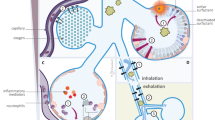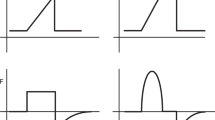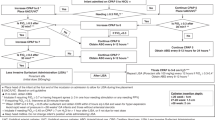Abstract
Meconium aspiration syndrome (MAS) is a complex syndrome that ranges in severity from mild respiratory distress to severe respiratory failure, persistent pulmonary hypertension of the newborn and sometimes death. Understanding of the syndrome's complicated pathophysiology will help determine the appropriate treatment strategy, including the use of continuous positive airway pressure (CPAP), conventional mechanical ventilation (CMV) and other therapies. Approximately 30 to 50% of infants diagnosed with MAS will require CPAP or mechanical ventilation. The optimum modes of ventilation for MAS are not known. Very few studies have been conducted to determine ‘best’ ventilatory strategies. Despite the introduction, over the last two decades, of innovative ventilatory treatments for this disease (for example, surfactant, high-frequency ventilation, inhaled nitric oxide, extracorporeal membrane oxygenation), the majority of infants can be successfully managed with CPAP or mechanical ventilation alone.
This is a preview of subscription content, access via your institution
Access options
Subscribe to this journal
Receive 12 print issues and online access
$259.00 per year
only $21.58 per issue
Buy this article
- Purchase on Springer Link
- Instant access to full article PDF
Prices may be subject to local taxes which are calculated during checkout




Similar content being viewed by others
References
Vidyasagar D, Yeh TF, Harris V, Pildes RD . Assisted ventilation in infants with meconium aspiration syndrome. Pediatrics 1975; 56: 208–213.
Bhutani VK, Chima R, Sivieri EM . Innovative neonatal ventilation and meconium aspiration syndrome. Indian J Pediatr 2003; 70 (5): 421–427.
Wiswell TE, Tuggle JM, Turner BS . Meconium aspiration syndrome: have we made a difference? Pediatrics 1990; 85: 848–852.
Wiswell TE, Gannon CM, Jacob J, Goldsmith L, Szyld E, Weiss K et al. Delivery room management of the apparently vigorous meconium-stained neonate: results of the multicenter, international collaborative trial. Pediatrics 2000; 105 (1 Part 1): 1–7.
Fraser WD, Hofmeyr GJ, Lede R, Faron G, Alexander S, Goffinet F et al. An international trial for the prevention of meconium aspiration syndrome. New Engl J Med 2005; 353: 909–917.
Halliday HL, Sweet D . Endotracheal intubation at birth for preventing morbidity and mortality in vigorous, meconium-stained infants born at term (Cochrane Review). The Cochrane Library, Issue 2, 2003. Oxford: Update Software.
Fuloria M, Wiswell TE . Managing meconium aspiration. Contemp Ob/Gyn 2000; July: 113–125.
Goetzman BW . Meconium aspiration. Am J Dis Child 1992; 146: 1282–1283.
Wiswell TE, Srinivasan P, Roberton NRC . Aspiration syndromes. In: Greenough A, Milner AD (eds). Neonatal Respiratory Disorders, 2nd edn, Arnold: London, UK, 2003, pp 334–354.
Harris TR, Herrick BR . Pneumothorax in the Newborn. Biomedical Communications, Arizona Health Sciences Center: Tucson, AZ, 1978.
Davey AM, Becker JD, Davis JM . Meconium aspiration syndrome: physiologic and inflammatory changes in a newborn piglet model. Pediatr Pulmonol 1993; 16: 101–108.
Zagariya A, Bhat R, Uhal B, Navale S, Freidine M, Vidyasagar D . Cell death and lung cell histology in meconium aspirated newborn rabbit lung. Eur J Pediatr 2000; 159: 819–826.
Dargaville PA, South M, McDougall PN . Surfactant and surfactant inhibitors in meconium aspiration syndrome. J Pediatr 2001; 138: 113–115.
Cleary GM, Wiswell TE . Meconium stained amniotic fluid and the meconium aspiration syndrome: an update. Pediatr Clin North Am 1998; 45: 511–529.
Fox WW, Gewitz MH, Dinwiddie R, Drummond WH, Peckham GJ . Pulmonary hypertension in the perinatal aspiration syndromes. Pediatrics 1977; 59: 205–211.
Walsh-Sukys M . Persistent pulmonary hypertension of the newborn: the black box revisited. Clin Perinatol 1993; 20: 127–143.
Goldsmith JP, Karotkin EH . Introduction. In: Goldsmith JP, Karotkin EH (eds). Assisted Ventilation of the Neonate, 4th edn, WB Saunders: Philadelphia, 2003, pp 1–14.
Simbruner G . Inadvertent positive end-expiratory pressure in mechanically ventilated newborn infants: detection and effect on lung mechanics and gas exchange. J Pediatr 1986; 108: 589–595.
Wood BR . Physiologic principles. In: Goldsmith JP, Karotkin EH (eds). Assisted Ventilation of the Neonate. 4th edn, WB Saunders: Philadelphia, 2003, pp 15–40.
Fox WW, Berman LS, Downes Jr JJ, Peckham GJ . The therapeutic application of end-expiratory pressure in the meconium aspiration syndrome. Pediatrics 1975; 56: 214–217.
Gupta A, Rastogi S, Sahni R, Bhutada A, Bateman D, Rastogi D et al. Inhaled nitric oxide and gentle ventilation in the treatment of pulmonary hypertension of the newborn—a single-center, 5 year experience. J Perinatol 2002; 22: 435–441.
Lakshminrusimha S, Ruddell JA, Steinhorn RH, Ryan RM, Gugino SF, Morin FC et al. Pulmonary arterial contractility in neonatal lambs increases with 100% oxygen resuscitation. Pediatr Res 2006; 59 (1): 137–141.
Ambalavanan N, Schelonka R, Carlo W . Ventilatory strategies. In: Goldsmith JP, Karotkin EH (eds). Assisted Ventilation of the Neonate, 4th edn, WB Saunders: Philadelphia, 2003, pp 249–259.
Drummond WH, Peckham GJ, Fox WW . The clinical spectrum of the newborn with persistent pulmonary hypertension. Clin Pediatr 1977; 16: 335–341.
Bifano EM, Pfannenstiel A . Duration of hyperventilation and outcome in infants with persistent pulmonary hypertension. Pediatrics 1988; 81: 657–666.
Walsh-Sukys MC, Tyson JE, Wright LL, Bauer CR, Korones SB, Stevenson DK et al. PPHN in the era before NO: practice variation and outcomes. Pediatrics 2000; 105 (1 Part 1): 14–20.
Mourani PM, Ivy DD, Gao D, Abman SH . Pulmonary vascular effects of inhaled nitric oxide and oxygen tension in bronchopulmonary dysplasia. Am J Respir Crit Care Med 2004; 170 (9): 1006–1013.
van Kaam AH, Haitsma JJ, De Jaegere A, van Aalderen WM, Kok JH, Lachmann B . Open lung ventilation improves gas exchange and attenuates secondary lung injury in a piglet model of meconium aspiration. Crit Care Med 2004; 32: 443–449.
Author information
Authors and Affiliations
Corresponding author
Additional information
Disclosure
JP Goldsmith has received consulting fees from Discovery Labs.
Rights and permissions
About this article
Cite this article
Goldsmith, J. Continuous positive airway pressure and conventional mechanical ventilation in the treatment of meconium aspiration syndrome. J Perinatol 28 (Suppl 3), S49–S55 (2008). https://doi.org/10.1038/jp.2008.156
Published:
Issue Date:
DOI: https://doi.org/10.1038/jp.2008.156
This article is cited by
-
Meconium aspiration syndrome: a comprehensive review
Journal of Perinatology (2023)
-
Can nasal continuous positive airway pressure be used as primary respiratory support for infants with meconium aspiration syndrome?
Journal of Perinatology (2019)
-
Current Concepts in the Management of Meconium Aspiration Syndrome
The Indian Journal of Pediatrics (2016)
-
Continuous positive airway pressure in preterm neonates: An update of current evidence and implications for developing countries
Indian Pediatrics (2015)



